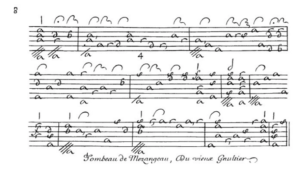Gaultier, Prelude and Tombeau de Mazangeau
Had we not all lived through 2020, we might be wondering why this man is performing from his hotel room. But if you are quarantined in a hotel, hope that it is a good one and that you have not forgotten your lute. I notice that Mr. Boysen, leaving nothing to chance, has two lutes with him.
 Vieux Gaultier (or old Gaultier) refers to Gaultier le Vieux Ennemond (1575-1651), sometimes also known as Gaultier de Lyon. He is not to be confused with his cousin Denis Gaultier (1597 or 1602/3 – 1672). Such confusion has led to works by both being occasionally misattributed, especially since Denis published a lute book that included works by Ennemond. Some of Ennemond’s works are included in the Bauyn Manuscript discussed last week in connection with Louis Couperin.
Vieux Gaultier (or old Gaultier) refers to Gaultier le Vieux Ennemond (1575-1651), sometimes also known as Gaultier de Lyon. He is not to be confused with his cousin Denis Gaultier (1597 or 1602/3 – 1672). Such confusion has led to works by both being occasionally misattributed, especially since Denis published a lute book that included works by Ennemond. Some of Ennemond’s works are included in the Bauyn Manuscript discussed last week in connection with Louis Couperin.
The Tombeau de Mazangeau may be the earliest tombeau in the repertoire. Tombeaux were written to commemorate the passing of a notable person, placing them in the same general category with lamentations. They were composed primarily for lute. Both Ennemond and Denis contributed to the form, which served as a model for English works like John Dowland‘s Flow My Tears.
Couperin brought the tombeau into the harpsichord repertoire. After being mostly discard in the 18th century, the form was revived by Ravel in his 1919 work Le tombeau de Couperin. Ravel did not specify which member of the Couperin family he intended to honor, but rather said that the work was intended to pay homage to the French Baroque suite style.
Since we discussed the unusual notation Louis Couperin’s unmeasured preludes last week, we might note the use of tablature this week. See the attached image. Lute music was often written in tablature. Instead of indicating pitches, tablature indicates individual strings and fret positions. It is in many ways a more intuitive form of notation for certain instruments, but a bit perplexing to those who want to see a representation of harmonic and melodic structure.



